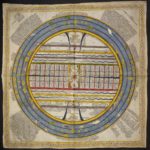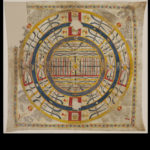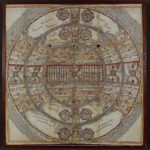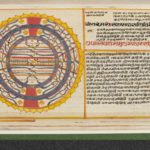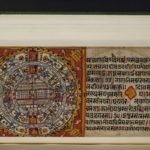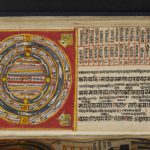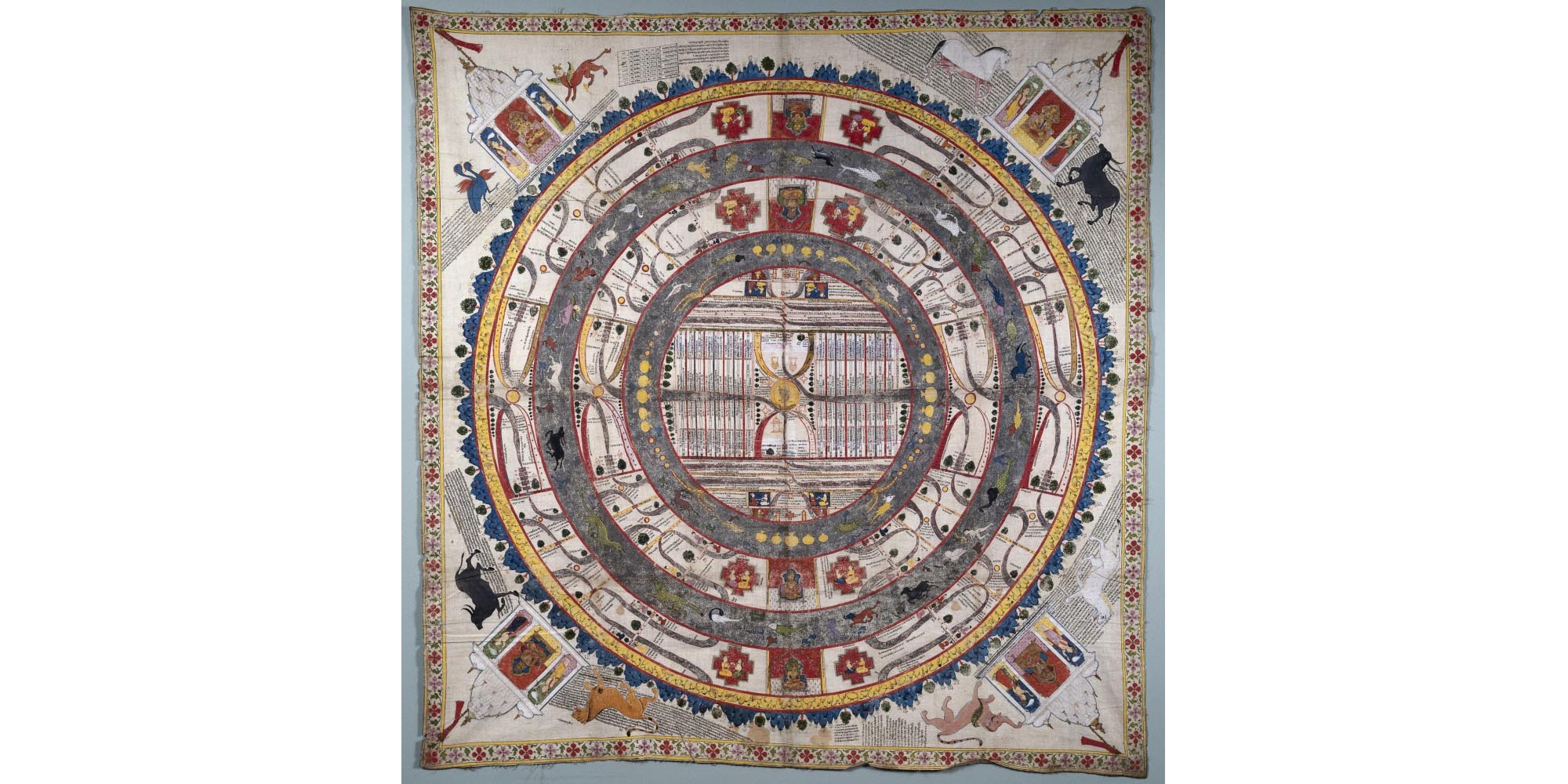
Background
Aḍhāī-dvīpa is a Hindi term meaning 'Two and A Half Continents''. The Two and A Half Continents is in the centre of the middle world – madhya-loka. There are three worlds in the Jain conception of the universe. The Two and A Half Continents is the only part of the universe where human beings can be born so it is also known as 'the world of humans' – manuṣya-loka.
The middle world in Jain tradition is formed of concentric rings of differing size. Every other ring is a continent, which is surrounded by a ring of ocean. These alternate rings of continents and oceans number 90 in all, but the Two and A Half Continents is the main focus of many works of Jain cosmology.
Starting from the centre, the Two and A Half Continents consists of the following elements:
- the central continent, called Jambū-dvīpa
- the first ocean, known as Lavaṇa-samudra or 'Salt Ocean'
- the second continent, Dhātakīkhaṇḍa
- the second ocean, called Kālodadhi or 'Black-Water Ocean'
- half of the third continent known as Puṣkara-dvīpa.
The maps of the Two and A Half Continents are very detailed and usually have long labels identifying the different elements. Based on the lengthy texts explaining Jain cosmology, the iconography is highly complex and characteristically repetitive and symmetrical.
Jambū-dvīpa – the first continent
The central circle in diagrams of the Two and A Half Continents is the first continent, Jambū-dvīpa. The innermost yellow disk is the cosmic axis, Mount Meru. It has three terraces set atop one another in decreasing order of size, and all planted with parks and forests. A temple to the Jinas is at the peak.
The semi-circles on each half of Mount Meru are the pairs of 'Elephant Tusk' – Gajadanta – mountains. These form the borders of the two Lands of Enjoyment.
|
Colour |
Location |
Region |
Name of associated tree |
|---|---|---|---|
|
Green |
North |
Uttara-kuru |
Jambū tree |
|
Red |
South |
Deva-kuru |
Śālmalī tree |
Here people can spend their days in pleasure because wish‑fulfilling trees enable them to get all they want without any effort.
Around Mount Meru are seven other regions – varṣa – picked out by six coloured lines. These symbolise parallel mountain ranges – varṣa-dhara. Apart from those in the north and south, the mountain ranges do not have standard colours in images of Jambū-dvīpa. The name of the range farthest north, Nīla, means 'dark blue' or 'dark', and is usually shown as green on maps. The mountain range in the south is generally red.
At the summits of each mountain range is a lake.
From south to north, these parts of Jambū-dvīpa are called:
|
Mountain range |
Lake at summit |
Region |
|---|---|---|
|
Himavant – 'Small Himavant' |
Padma |
Bharata and Haimavata |
|
Mahā-himavant – 'Large Himavant' |
Mahā-padma |
Harivarsa |
|
Nisadha |
Tigiñcha |
Mahā-videha |
|
Nīla |
Kesarī |
Ramyaka |
|
Rukmin or Rūpī |
Mahā-puṇḍarīka |
Hairaṇyavata |
|
Śikharin |
Puṇḍarīka |
Airāvata |
These lakes are the sources of two rivers that flow east and west respectively through the seven regions. Both rivers flow into the Lavaṇa-samudra.
At the far north and south of these regions are the twin mountain ranges of Vaitāḍhya.
The Mahā-videha region forms a wide block in the centre of the diagram. The region is made up of 32 provinces between the mountain ranges of Niṣadha and Nīla. These provinces are divided into 16 oblongs in the east and 16 in the west. These two sets of oblongs are split into smaller groups of eight oblongs on each side of the rivers that run through the seven central regions. Forests mark the boundary of the region.
There are gates at the four cardinal points of Jambū-dvīpa, which open the land to the ocean:
- north – Vaijayanta
- south – Aparājita
- east – Vijaya
- west – Jayanta.
Lavaṇa-samudra – the first ocean
Around Jambū-dvīpa is the first ocean, Lavaṇa-samudra or 'Salt Ocean'.
In the water four sets of pots – pātālas or kalaśas – are suspended. They are filled with water and then emptied and filled with air in a regular cycle, which regulates the tides. Their locations correspond to the four directions. There are four big ones and 7,884 smaller ones, with 1,971 smaller ones at each compass point.
Tidal movement is also directed by the Shore Retainers – Velaṃ-dharas. Four large ones lie at the cardinal directions and four small ones in between each point. The name means both the mountains and the dragons that live inside.
Eight tusk-shaped peninsulas extend into the sea from Jambū-dvīpa, each containing seven inhabited regions. These make up the 56 Intermediate Islands – Antara-dvīpa.
Dhātakīkhaṇḍa – the second continent
The second, larger concentric ring is the continent of Dhātakīkhaṇḍa. Although double the size of Jambū-dvīpa, this is never clear in cosmological artwork.
A mountain range called Iṣvākāra or 'Arrow Shaped' runs north to south, dividing Dhātakīkhaṇḍa into eastern and western halves. Jain temples within vertical lines mark the range of mountains. One temple sits in the southern half, the other in the north.
Dhātakīkhaṇḍa's eastern and western halves each hold a Mount Meru, on the same plane as the central one.
Each half of Dhātakīkhaṇḍa also holds seven regions with the same name as the seven regions in Jambū-dvīpa. There are six mountain ranges in each half, dividing the seven regions from each other. Thus Dhātakīkhaṇḍa has a total of 14 regions and 12 mountain ranges.
Kālodadhi – the second ocean
Dhātakīkhaṇḍa is enclosed by Kālodadhi or 'Black-Water Ocean', which is the second ocean in the Two and A Half Continents.
There are no tides in Kālodadhi but there are two islands in the eastern and western parts ruled by the two deities Kāla and Mahā-kāla.
Puṣkara-dvīpa – the third continent
The outermost ring shows half of the third continent, Puṣkara-dvīpa. Only the inner half, where human beings live, is shown.
At the perimeter of Puṣkara-dvīpa is a ring of mountains known as Mānuṣottara-parvata or 'Mountain beyond Mankind'. It is 1721 yojanas high and 1022 yojanas broad. On the other side of the range lies the half of the continent where humans cannot live.
Like Dhātakīkhaṇḍa, Puṣkara-dvīpa is split into eastern and western parts by the Iṣvākāra mountains. Again, each half has a Mount Meru on the horizontal axis.
Transcription
A full transliteration and translation of this elaborate text has to be left for a later stage. Here is a brief sample of the text, which is written in Rajasthani, using the Devanāgarī script.
This sample transliteration is of the text in the yellow circular strip representing the Māṇuṣottara-parvata.
lakṣa 16 00000 Pukharavara-dvīpa chai. tiṇa madhye eṣaḥ Mānuṣottara-parvata arddha-Puṣkarārdha hai madhye hai. Puṣkarārdha 8 lāṣa ro chai. tiṇa su vāhya disi Mānuṣottara-parvata chai. tiṇa su āgai 8 lākha Puṣkarārddha hai. 1022 yo uṇo chai. Mānuṣottara ucccatve 1721 yo, nīcai vistāra 1022, upari vistāra 424 yo. tasyopari caturddaśi 4 kūṭa hai. tiṇāṃ 4 kūṭā upari 4 śrīJineśvaradevajī nā deharā chai. te jāṇivā Mānuṣottara sīhai nisāī hai, jima siṃha baiṭho huvai tima āpaṇa disi uccatta chai te sama++chai pūvāhiva++āva uttāra chai //
Translation
A full transliteration and translation of this elaborate text has to be left for a later stage. Here is a brief sample of the text, which is written in Rajasthani, using the Devanāgarī script.
This sample translation is of the text in the yellow circular strip representing the Māṇuṣottara-parvata.
The Puṣkaravara continent measures 1,600,000 yojanas. In its centre is the Mānuṣottara mountain range. There is half a Puṣkara [continent]. It is in the middle. Half a Puṣkara measures 800,000 yojanas. At its outer side is the Māṇuṣottara. Beyond it is another half Puṣkara, which has 800,000 yojanas. Its size is 1,022 yojanas. The Mānuṣottara is 1,721 yojanas high. Its width at the bottom is 1,022, its width at the top 424 yojanas. On the top in the four directions there are four peaks. On the four peaks there are four temples dedicated to the Jinas. It should be known that the Mānuṣottara [has the shape of] the lion’s position. It is like a seated lion [sitting on his haunches with straight forelegs].
Glossary
Description
The main part of the diagram consists of concentric circles in alternating grey and white around a central circle. In the centre of the diagram is Mount Meru, shown as a yellow disc, the heart of the Two and A Half Continents. On Mount Meru sits a Jina on a throne but this is now hardly visible.
Mount Meru is in the middle of the circular continent of Jambū-dvīpa, shown with a pale background. Around Jambū-dvīpa is the ocean of Lavaṇa-samudra, shown as a grey circle.
Around Lavaṇa-samudra is the continent of Dhātakīkhaṇḍa. Around that is the ocean of Kālodadhi, again a grey circle.
Around Kālodadhi is another circle of land. This is half of the Puṣkara continent.
Together, these continents and oceans form Aḍhāī-dvīpa or 'Two and A Half Continents'. Thus the painting is a map of the cosmological concept of Two and A Half Continents. The Two and A Half Continents is in the centre of the middle world – madhya-loka. There are three worlds in the Jain conception of the universe. The Two and A Half Continents is the only part of the Jain universe where human beings can be born so it is also known as 'the world of humans' – manuṣya-loka.
At the perimeter of Puṣkara-dvīpa is a slim yellow band. Outside this runs a repeated triangular pattern in blue. The yellow band is the outer mountain range beyond which no human beings live. In this diagram the blue pattern is a ring of mountain ranges with trees in between.
This painting is unusual in that the waters of the two oceans and the rivers are rarely shown in grey, as they are here. Figures representing inhabitants of the continents and important sites are mapped in fine detail and often given long descriptions. The painter's creativity is also plain in the depiction of the animals in the second ocean, the Kālodadhi. There are fish and other aquatic animals, but also other kinds of creatures, some of which are more fantastic than real and look like prehistoric animals.
Other visual elements
As is usual, there is a Jain temple at each of the four corners of the painting. There is an image of a Jina in the centre, who is being worshipped by a devotee waving a fly-whisk on each side.
Each Jain temple is flanked by pairs of animals, which is not common in maps of the Two and A Half Continents. The reasons for choosing these animals are not known, but some of them are emblems associated with a specific Jina:
- bull with the first Jina, Ṛṣabhanātha or Lord Ṛṣabha
- elephant with the second Jina, Ajitanātha or Lord Ajita
- lion with the 24th Jina, Mahāvīra
- horse with the third Jina, Saṃbhavanātha or Lord Saṃbhava
- birds with the fourth Jina, Abhinandananātha or Lord Abhinandana.
Note the semi-fantastic creature in the upper left corner.
The floral border around the edge of the painting is a fine ornamentation.
Text portions and chart
On either side of each temple in the corners of the cloth are small paragraphs of writing. These give more detail about Jambū-dvīpa and the other parts of the Two and A Half Continents. The script is written as if the reader is at the edge of the material, looking into its centre. This means the reader must move around the border of the fabric to read it, because staying in one place would mean reading some of the script upside down or at right angles.
Top-left corner
Looking from the bottom of this image, on the right side of the temple in the top-left corner is a chart. It contains the dimensions of the mountain ranges which divide Jambū-dvīpa into regions. Going from south to north, they are:
- Vaitāḍhya
- Himavanta
- Mahāhimavanta
- Niṣadha
- Nīla
- Rūpi
- Śikharī
- Vaitāḍhya.
To the left of this chart is information in Sanskrit about the cities.
Bottom-left corner
The script where the bull is located is written in Sanskrit and gives the dimensions of the second continent, the Dhātakīkhaṇḍa.
Top-right corner
Again, the script on the side where the bull is located is in Sanskrit. Here it gives topographical details of Mount Meru, the forests on its terraces and so on. Then there is information about the 'followers' or tributaries of the main rivers – nadī-parivāra.
The script on the left side of the temple, where the horse is, is in Sanskrit too. It describes the trees and mountains on the Uttara-kuru and the Deva-kuru, and the temples there and in the Mahā-videha regions.
- Source:
Wellcome Trust Library
- Shelfmark:
575181i
- Author:
unknown
- Date of creation:
19th century
- Folio number:
N/A
- Total number of folios:
not applicable
- Place of creation:
western India
- Language:
Gujarati / Rajasthani with Sanskrit and Prākrit quotations
- Medium:
watercolour on cloth
- Size:
108.5-111 x 107.1 cm
- Copyright:
Wellcome Library, London
- Image Copyright:
- +
- aAbhavya
- aAbhinandana
- aAbhiṣeka
- aĀcāra
- aĀcārāṅga-sūtra
- aĀcārya
- aAchalbhrata
- aAḍhāī-dvīpa
- aAdharma
- aAdho-loka
- aAdhyayana
- aAdvaita Vedānta
- aĀgama
- aAghātīya
- aAghātīya-karman
- aAgnibhuti
- aAgra
- aĀhāra
- aAhiṃsā
- aAhimsa Day
- aAjita
- aAjīva
- aAkampit
- aĀkāśa
- aAkbar the Great
- aAkṣaya-tṛtīyā
- aAlauddin Khalji
- aAlbert Einstein
- aAllah
- aAlms
- aĀlocanā
- aAloka-ākāśa
- aAmāri
- aAmbikā or Kūṣmāṇḍinī
- aAnagāra
- aAnanta
- aAnarthadaṇḍa
- aAnaśana
- aAnekānta-vāda
- aAṅga
- aAniconism
- aAnojjā
- aAntarāla
- aAntarāya-karma
- aAṇu
- aAṇu-vrata
- aAnukampā
- aAnuprekṣā
- aAnusvāra
- aApabhraṃśa
- aAparigraha
- aAra
- aĀrambha
- aĀrambhaja
- aĀratī
- aArdhamāgadhī Prākrit
- aArhaṃ
- aArhat
- aArśana-āvaraṇīya-karma
- aĀrta-dhyāna
- aĀryikā
- aĀryikā Jñānamati
- aĀśātanā
- aĀścarya
- aAscetic
- aAsceticism
- aAshram
- aAspiration
- aĀsrava
- aAṣṭa-maṅgala
- aAṣṭāpada
- aAstikāya
- aAstrolabe
- aAsura
- aAtheism
- aAticāra
- aAtiśayakṣetra
- aAtithisaṃvibhāgavrata
- aĀtma-vāda
- aĀtman
- aAuṃ
- aAurangzeb
- aAuspicious
- aAusterity
- aAvadhāna
- aAvadhi-jñāna
- aĀvaraṇī-yakarman
- aAvasarpiṇī
- aAvatāra
- aAvidyā
- aAxiom
- aĀyāga-paṭa
- aĀyambil
- aĀyu-karma
- aĀyurveda
- bBabur
- bBāhubali
- bBaladeva
- bBālāvabodha
- bBandha
- bBasadi
- bBazaar
- bBhadrankarvijay
- bBhagavant
- bBhaktāmara-stotra
- bBhakti
- bBhale
- bBharata
- bBhāṣā
- bBhāṣya
- bBhaṭṭāraka
- bBhāva
- bBhāva-pūjā
- bBhāvanā
- bBhavana-vāsin
- bBhavya
- bBhavyatva
- bBhaya
- bBhoga-bhūmi
- bBhogopabhoga
- bBodhi
- bBollywood
- bBrahmā
- bBrahma-deva
- bBrahmacārī
- bBrāhmaṇa
- bBraj Bhāṣā
- bBright fortnight
- bBritish Raj
- bBuddha
- bBuddhi-sagar
- bBuddhism
- bBuddhist
- cCaitya
- cCaityavāsin
- cCakravartin
- cCakreśvarī
- cCāmara
- cCandanā
- cCandragupta
- cCandraprabha
- cCanon
- cCāritra
- cCāritramohanīya-karman
- cCarũrī
- cCaste
- cCaturvidha-saṅgha
- cCaturviṃśati-stava
- cCāturyāma
- cCE
- cCelibacy
- cCha
- cChadmastha
- cChastity
- cCheda-sūtra
- cChristian
- cChristianity
- cClergy
- cCloning
- cColophon
- cCommentary
- cConch
- cConfession
- cCongregation
- cConsecration
- cCosmology
- cCremation
- cCrore
- cCult
- cCūrṇi
- dDādā-guru
- dDalit
- dDāna
- dDaṇḍa
- dDark fortnight
- dDarśana
- dDarśanamohanī-yakarman
- dDaśa-lakṣaṇa-parvan
- dDeity
- dDelhi Sultanate
- dDerāsar
- dDeśāvakāśika-vrata
- dDetachment
- dDevanāgarī
- dDevānandā
- dDevarddhi-gani
- dDevotee
- dDhamal
- dDhanuṣ
- dDhāra
- dDharma
- dDharma-dhyāna
- dDharma-sāgara
- dDharmastikaya
- dDhātakīkhaṇḍa
- dDholak
- dDhyāna
- dDiaspora
- dDig-vrata
- dDigambara
- dDīkṣā
- dDisciple
- dDīvālī
- dDivya-dhvani
- dDNA
- dDoctrine
- dDogma
- dDonor
- dDoṣa
- dDravya
- dDravya-pūjā
- dDrone
- dDuṣamā
- dDuṣamā-duṣamā
- dDuṣamā-suṣamā
- dDveṣa
- dDvīpa
- eEast India Company
- eEightfold Path
- eEkānta-vāda
- eEkendriya
- eElder
- eElders
- eEschatology
- eEtc up to
- fFarmān
- fFast
- fFatehpur Sikri
- fFestival
- fFestschrift
- fFiruz Shah
- fFly-Whisks
- fFolio
- fFour Noble Truths
- gGaccha
- gGaṇa
- gGaṇadhara
- gGanadharavada
- gGaṇeśa
- gGaṇin
- gGarba
- gGarbha
- gGarbha-gṛha
- gGaruḍa
- gGati
- gGene
- gGenomics
- gGhātī-yakarman
- gGhātīya
- gGhaznavid
- gGhiyasuddin Tughlaq
- gGhurid
- gGloss
- gGotra-karma
- gGujarāt
- gGujarati
- gGuṇa
- gGuṇa-sthāna
- gGuṇa-vrata
- gGupti
- gGuru
- gGuruṇī
- hHagiography
- hHajj
- hHaṃsa
- hHaribhadra
- hHariṇaigameṣin
- hHasta
- hHeresy
- hHiṃsā
- hHindi
- hHindu
- hHinduism
- hHīravijaya
- hHoroscope
- hHrīṃ
- hHumayun
- hHymn
- iIconoclasm
- iIconography
- iIdol
- iIndian Independence
- iIndology
- iIndra
- iIndrabhūti Gautama
- iIndriya
- iInitiation
- iIntercession
- iInvocation
- iIQ
- iIslam
- iIslamicate
- iIṣṭadevatā
- iĪśvara
- jJagat
- jJahangir
- jJain
- jJaina Devanāgarī
- jJaina Śaurasenī
- jJaina-dharma
- jJainaśāsana
- jJainness
- jJaisalmer
- jJamāli
- jJambū-dvīpa
- jJames Burgess
- jJanma
- jJanma-kalyāṇa
- jJarā
- jJāti
- jJina
- jJina-āgama
- jJina-bhavana
- jJina-bimba
- jJina-mātā
- jJinacandra-sūri
- jJinadatta
- jJinaprabha
- jJīva
- jJñāna
- jJñāna-āvaraṇīya-karma
- jJñāna-āvarṇiya
- jJñānsundar
- jJyotiṣka
- kKāla
- kKālakācārya-kathā
- kKālidāsa
- kKalpa-sūtra
- kKalpa-vṛkṣa
- kKalyāṇaka
- kKalyanvijay
- kKamaṇḍalu
- kKamaṭha
- kKarma
- kKarma-bhūmi
- kKarma-grantha
- kKarma-prakṛti
- kKarma-vāda
- kKarmon
- kKarnataka
- kKaṣāya
- kKathā
- kKāvya
- kKāya
- kKāyotsarga
- kKeśa-loca
- kKetu
- kKevala-jñāna
- kKevalin
- kKhalji
- kKharatara-gaccha
- kKnowledge
- kKriyā
- kKriyā-vāda
- kKṛṣṇa
- kKṣamā-śramaṇa
- kKṣapakaśreṇi
- kKṣatriya
- kKṣullaka
- kKulakara
- kKundakunda
- kKunthu
- lLabdhi
- lLaity
- lLakh
- lLāñchana
- lLands of Action
- lLaukāntika
- lLavaṇa-samudra
- lLeśyā
- lLiṅga
- lLinguistics
- lLoka
- lLoka-ākāśa
- lLoka-puruṣa
- lLoka-vāda
- lLotus
- lLotus lake
- mMadhya-loka
- mMahā-videha
- mMahā-vrata
- mMahābhārata
- mMahāmastakābhiṣeka
- mMāhārāṣṭra
- mMāhārāṣṭrī Prākrit
- mMahattarā Yākinī
- mMahāvīr Jayantī
- mMahāvīra
- mMakāra
- mMakkhali Gośāla
- mMalli
- mMāna-stambha
- mManaḥ-paryāya-jñāna
- mMaṇḍala
- mMaṇḍapa
- mMandit
- mMaṅgala
- mMantra
- mMantras
- mManuṣya-loka
- mMarāṭhī
- mMārgaṇā
- mMartyr
- mMarudevī
- mMaṭha
- mMati-jñāna
- mMauryaputra
- mMecca
- mMendicant lineage
- mMetarya
- mMiracle
- mMithyādṛṣṭi
- mMohandas Gandhi
- mMohanīya-karma
- mMokṣa
- mMonastic order
- mMonasticism
- mMonk
- mMonotheism
- mMosque
- mMount Meru
- mMount Sammeta
- mMṛgāvatī
- mMughal
- mMuhammad
- mMuhammad bin Tughlaq
- mMuhpattī
- mMūla-sūtra
- mMūlaguṇa
- mMumbaī
- mMuni
- mMunisuvrata
- mMurad Bakhsh
- mMūrti-pūjaka
- mMuslim
- mMysticism
- nNābhi
- nNāga-kal
- nNāgapurīya Tapā-gaccha
- nNāgarī
- nNāma-karma
- nNamaskāra-mantra
- nNami
- nNandīśvara-dvīpa
- nNandivardhana
- nNandyāvarta
- nNāraka
- nNāraki
- nNasalisation
- nNātha
- nNavrātrī
- nNaya-vāda
- nNemi
- nNidāna
- nniggaṃthāṇa vā 2
- nniggaṃtho vā 2
- nNigoda
- nNihnava
- nNikṣepa
- nNirgrantha
- nNirjarā
- nNirvāṇa
- nNiryukti
- nNiṣidhi
- nNitya
- nNiyati
- nNo-kaṣāya
- nNudity
- nNun
- oOcean of milk
- oOmniscience
- oOrdination
- ppa°
- pPadmaprabha
- pPadmāsana
- pPadmāvatī
- pPādukā
- pPalanquin
- pPalette
- pPañca-muṣṭi
- pPāṇḍava
- pPaṇḍit
- pPandit Dalsukh D. Malvania
- pPandit Sukhlalji
- pPāṇipātra
- pPāpa
- pParamātman
- pParameṣṭhin
- pPāraṇā
- pParigraha
- pPariṇāma
- pParīṣaha
- pParokṣa
- pPārśva
- pPārśvanātha
- pParyāya
- pParyuṣaṇ
- pPaṭa
- pPatan
- pPātra
- pPenance
- pPersian
- pPhala
- pPhilology
- pPicchikā
- pPilgrimage
- pPīr
- pPolymath
- pPoṣadha
- pPossession
- pPothī
- pPrabhas
- pPradakṣiṇā
- pPradeśa
- pPrākāra
- pPrakīrṇaka-sūtra
- pPrākrit
- pPramāda
- pPramukhā
- pPrati-vāsudeva
- pPratikramaṇa
- pPratimā
- pPratiṣṭhā
- pPratyākhyāna
- pPratyakṣa
- pPravacana
- pPrāyaścitta
- pPrayer
- pPre-modern
- pPreach
- pPredestination
- pProtestant
- pProvenance
- pPudgala
- pPūjā
- pPujārī
- pPukharavara-dvīpa
- pPuṇya
- pPūrva
- pPuṣkara-dvīpa
- pPuṣpadanta
- pPyre
- qQur’an
- rRāga
- rRāhu
- rRainy season
- rRajasthan
- rRajasthani
- rRājimatī
- rRajoharaṇa
- rRajput
- rRāma
- rRāmāyaṇa
- rRangoli
- rRās-garbā
- rRasa
- rRathanemi
- rRatna-traya
- rRātri-bhojana
- rRaudra-dhyāna
- rRecto
- rRelic
- rRenunciation
- rRetroflex
- rRevatī
- %Ṛg-veda
- rRite
- rRosary
- %Ṛṣabha
- %Ṛṣabhanātha
- rRupee
- sSaciyā Mātā
- sSādhu
- sSādhvī
- sSāgāra
- sSaint
- sŚaivaism
- sŚaka-saṃvat
- sSallekhanā
- sŚalya
- sSamacatuṣṭha
- sSamādhimaraṇa
- sSamaṇi
- sSāmarambha
- sSamavasaraṇa
- sSāmāyika
- sSaṃbhava
- sSamiti
- sSaṃjñā
- sSaṃkalpaja
- sSaṃsāra
- sSamudghāta
- sSaṃvara
- sSaṃvega
- sSamyak-cāritra
- sSamyak-darśana
- sSamyak-jñāna
- sSamyaktva
- sSaṃyama
- sSanctuary
- sSandalwood
- sSaṇgha
- sSanskrit
- sSant
- sŚānti
- sSapta-bhaṅgi-naya
- sSārambha
- sSarasvatī
- sSarvajña
- sSāsan-devi
- sŚāsana-devatā
- sŚāstra
- %Ṣaṭ-jīvanikāya
- sSatī
- sSatīmātā
- sSatya
- sSchism
- sScribe
- sScripture
- sSect
- sSecularism
- sŚenāī
- sSermon
- sŚeṣavatī
- sSevā
- sSeven fields of donation
- sShah Jahan
- sShantidas Jhaveri
- sShrine
- sSiddha
- sSiddha-śilā
- sSiddhacakra or Navadevatā
- sSiddhānta
- sSiddhārtha
- sSiddhi
- sSikh
- sSikhism
- sŚikṣā-vrata
- sŚīla
- sSin
- sSindh
- sŚītala
- sŚiva
- sSkandha
- sSomanatha
- sŚraddhā
- sŚramaṇa
- sŚrāvaka
- sŚrāvakācāra
- sŚrāvikā
- sŚreyāṃsa
- sŚrī
- sŚrīvatsa
- sŚruta-jñāna
- sŚruta-pañcamī
- sSthānaka-vāsin
- sSthāpanācārya
- sSthāvara
- sSthavira
- sSthiti
- sStrīmukti
- sStūpa
- sSubcontinent
- sSudarshana
- sŚuddhi
- sSudharma
- sŚūdra
- sSufism
- sSukha
- sŚukla-dhyāna
- sSulasā
- sSultan
- sSumati
- sSundarśrī
- sSupārśva
- sSūri
- sSuṣamā
- sSuṣamā-duṣamā
- sSuṣamā-suṣamā
- sSūtra
- sSuyam me ausam! Tenam bhagavaya evamakkhayam
- sSvādhyāya
- sSvāhā
- sSvastika
- sŚvetāmbara
- sŚvetāmbara Terāpanthin
- sŚvetāmbaras
- sSwan
- sSyād-vāda
- tTabla
- tTantra
- tTapā-gaccha
- tTapas
- tTāraṇ Svāmī Panth
- tTattva
- tTattvārtha-sūtra
- tTemple
- tTemple-city
- tThe Enlightenment
- tTheology
- tThree worlds
- %Ṭīkā
- tTilaka
- tTīrtha
- tTīrthaṃkaranāma-karman
- tTīrthankara
- tTransliteration
- tTrasa
- tTrasa-nāḍī
- tTriśalā
- tTriṣaṣṭi-śalākā-puruṣa-caritra
- tTti bemi
- tTughlaq
- tTunk
- uUdumbara
- uUniversal History
- uUpādhyāya
- uUpāṅga
- uUpaniṣads
- uUpāsaka
- uUpasarga
- uUpāśraya
- uŪrdhva-loka
- uUtsarpiṇī
- uUttarādhyayana-sūtra
- vVāhana
- vVaimānika
- vVairāgya
- vVaiṣṇava
- vVaiśramaṇa
- vVaiśya
- vValabhī
- vVanaspatikāya
- vVandana
- vVaṇik
- vVarṇa
- vVāsudeva
- vVāsupūjya
- vVayubhūti
- vVeda
- vVedanīya-karma
- vVegetarianism
- vVehicle
- vVernacular
- vVerso
- vVidyā
- vVidyā-devī
- vVihāra
- vVijñapti-patra
- vVikrama-saṃvat
- vVikṛti
- vVimala
- vVinaya
- vVipāka
- vVirji Vora
- vVirodhaja
- vVīrya
- vVisarga
- vViṣṇu
- vVītarāga
- vVizier
- vVotive
- vVow
- vVrata
- vVS
- vVyakta
- vVyantara
- vVyasana
- yYakṣa
- yYakṣī
- yYantra
- yYaśoda
- yYaśovijaya
- yYati
- yYātrā
- yYoga
- yYoginī
- yYojana
Description
The main part of the diagram consists of concentric circles in alternating grey and white around a central circle. In the centre of the diagram is Mount Meru, shown as a yellow disc, the heart of the Two and A Half Continents. On Mount Meru sits a Jina on a throne but this is now hardly visible.
Mount Meru is in the middle of the circular continent of Jambū-dvīpa, shown with a pale background. Around Jambū-dvīpa is the ocean of Lavaṇa-samudra, shown as a grey circle.
Around Lavaṇa-samudra is the continent of Dhātakīkhaṇḍa. Around that is the ocean of Kālodadhi, again a grey circle.
Around Kālodadhi is another circle of land. This is half of the Puṣkara continent.
Together, these continents and oceans form Aḍhāī-dvīpa or ‘Two and A Half Continents’. Thus the painting is a map of the cosmological concept of Two and A Half Continents. The Two and A Half Continents is in the centre of the middle world – madhya-loka. There are three worlds in the Jain conception of the universe. The Two and A Half Continents is the only part of the Jain universe where human beings can be born so it is also known as ‘the world of humans’ – manuṣya-loka.
At the perimeter of Puṣkara-dvīpa is a slim yellow band. Outside this runs a repeated triangular pattern in blue. The yellow band is the outer mountain range beyond which no human beings live. In this diagram the blue pattern is a ring of mountain ranges with trees in between.
This painting is unusual in that the waters of the two oceans and the rivers are rarely shown in grey, as they are here. Figures representing inhabitants of the continents and important sites are mapped in fine detail and often given long descriptions. The painter’s creativity is also plain in the depiction of the animals in the second ocean, the Kālodadhi. There are fish and other aquatic animals, but also other kinds of creatures, some of which are more fantastic than real and look like prehistoric animals.
Other visual elements
As is usual, there is a Jain temple at each of the four corners of the painting. There is an image of a Jina in the centre, who is being worshipped by a devotee waving a fly-whisk on each side.
Each Jain temple is flanked by pairs of animals, which is not common in maps of the Two and A Half Continents. The reasons for choosing these animals are not known, but some of them are emblems associated with a specific Jina:
- bull with the first Jina, Ṛṣabhanātha or Lord Ṛṣabha
- elephant with the second Jina, Ajitanātha or Lord Ajita
- lion with the 24th Jina, Mahāvīra
- horse with the third Jina, Saṃbhavanātha or Lord Saṃbhava
- birds with the fourth Jina, Abhinandananātha or Lord Abhinandana.
Note the semi-fantastic creature in the upper left corner.
The floral border around the edge of the painting is a fine ornamentation.
Text portions and chart
On either side of each temple in the corners of the cloth are small paragraphs of writing. These give more detail about Jambū-dvīpa and the other parts of the Two and A Half Continents. The script is written as if the reader is at the edge of the material, looking into its centre. This means the reader must move around the border of the fabric to read it, because staying in one place would mean reading some of the script upside down or at right angles.
Top-left corner
Looking from the bottom of this image, on the right side of the temple in the top-left corner is a chart. It contains the dimensions of the mountain ranges which divide Jambū-dvīpa into regions. Going from south to north, they are:
- Vaitāḍhya
- Himavanta
- Mahāhimavanta
- Niṣadha
- Nīla
- Rūpi
- Śikharī
- Vaitāḍhya.
To the left of this chart is information in Sanskrit about the cities.
Bottom-left corner
The script where the bull is located is written in Sanskrit and gives the dimensions of the second continent, the Dhātakīkhaṇḍa.
Top-right corner
Again, the script on the side where the bull is located is in Sanskrit. Here it gives topographical details of Mount Meru, the forests on its terraces and so on. Then there is information about the ‘followers’ or tributaries of the main rivers – nadī-parivāra.
The script on the left side of the temple, where the horse is, is in Sanskrit too. It describes the trees and mountains on the Uttara-kuru and the Deva-kuru, and the temples there and in the Mahā-videha regions.





























































































